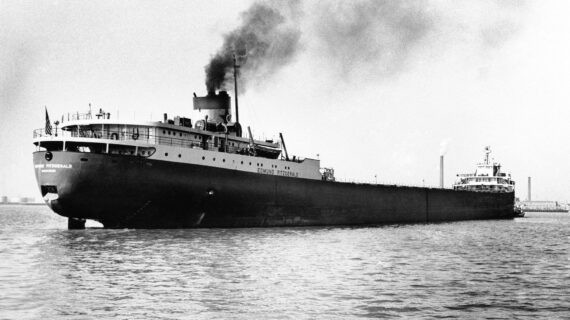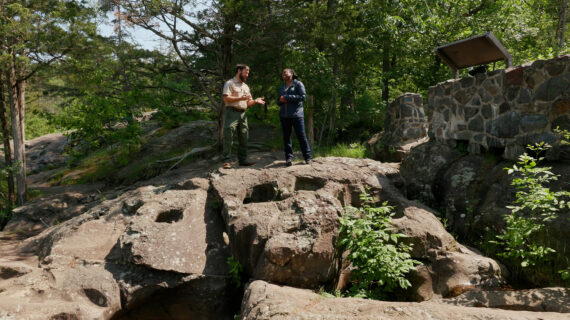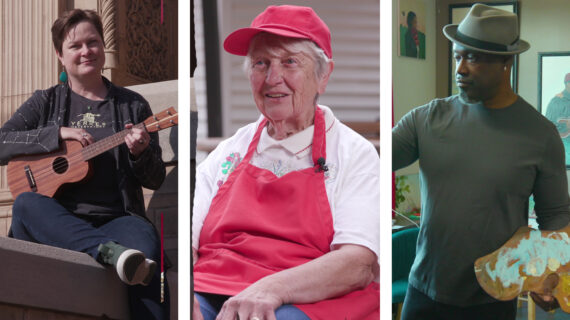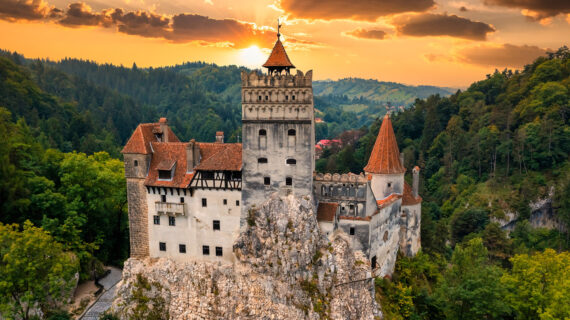[gentle music] – Welcome to University Place Presents.
I’m Norman Gilliland.
During the 20th century, a fair number of U.S. presidents have been able, quite successfully, to project American policy and power in speeches given overseas.
How did they go about it?
With me is Allison Prasch; she’s a professor of Communications, Comm Arts, at the UW-Madison, and also the author of the book The World is Our Stage: The Global Rhetorical Presidency and the Cold War, published by the University of Chicago Press in 2023.
Welcome to University Place Presents.
– Thank you so much for having me.
– A fascinating topic whenever you’re talking about communication and presidents, but in terms of global thinking, the 20th century, because of the technology, pretty much is where it is.
Of course, 21st century too.
– Mm-hmm, absolutely.
Well, and I think when we’re talking about the projection of American power and influence, we have to look at one of the first instances of where and how a president chose to go abroad because it’s not just the fact that they wanted to leave the country.
It’s also the fact that they wanted to articulate and embody what U.S. foreign policy meant at key junctures during the 20th century.
– So the first U.S. president to go abroad during his presidency was… – Teddy Roosevelt; in 1906, he makes the decision to travel to the Panama Canal Zone.
And in that tour, he begins to help U.S. Americans see and understand the relationship of Panama to the United States.
– And how does he go about that?
What is the technology?
– Well, so Teddy Roosevelt set sail in November 1906, and he makes the decision to be very public about his decision to go abroad.
And as you might imagine, because it is the first time that a U.S. president is leaving the borders of the nation while in office, Teddy Roosevelt will be very explicit with his audience and journalists that he is going abroad as an emissary for the U.S. public.
And so, although journalists and political pundits are very concerned about the fact that maybe Roosevelt won’t be able to do the duties of his office, he’s very clear about, “I can be reached by telegraph in various places.”
But he also makes the decision to bring journalists with him who are going to photograph him being in specific places.
And so one of the most iconic images that we have of Teddy Roosevelt in the Panama Canal Zone is this image of Roosevelt sitting on one of the building materials, this digger essentially in early 20th century terms that is part of the construction of the Panama Canal.
– And that right away implies this projection of power ’cause he’s on this massive machine, this changer of world transportation.
– Absolutely, and it also demonstrates the fact that the United States was very invested in building the Panama Canal.
They knew that it was going to be really important for the U.S. economy, for global trade, but Teddy Roosevelt also goes down there because there is grave public concern of what he will describe as “getting down into the ditch.”
And so he’ll say to the public, “I wanna see what’s going on down in the ditch.
“I’m gonna go look at it for you.
“I’m going to see it with my own eyes, and I will come back “and report to the U.S. public of what I saw “and why U.S. involvement in doing this construction project in the Panama Canal Zone is so important and necessary.”
– And so these pictures of T.R.
would’ve shown up in, like, the Hearst newspapers and all the other big periodicals of the time.
– Absolutely, and one of the most notable examples of this is when Teddy Roosevelt returns to the United States, he’s very deliberate about wanting to make sure that citizens see these images, not just in The New York Times.
There is a 13-page spread where citizens can see images not just of Teddy Roosevelt, but also his surroundings and what it looks like to be creating the Panama Canal.
But he also makes sure that these images are published in the Congressional Record.
And it’s the first time that images are actually part of the Congressional Record.
And for some senators, they’re very concerned about this.
They feel like this is a deviation of norms.
– So non-traditional.
– So non-traditional, right?
But Roosevelt is adamant that he wants the public to see him in the Panama Canal Zone.
And of course for Roosevelt, this is really an extension of American power and influence in South America.
He believes that the United States should have a role to play in how these democracies or what should become democracies, according to him, are going to hold themselves to a particularly higher standard, he says.
And so he believes that these images are going to help the public envision the United States’ role in the world at this moment.
– When we get to the years of World War I, and now United States is really involved in international affairs.
And the President of the United States, Woodrow Wilson, is very much involved, both hands, international affairs, pushing the League of Nations, of course, getting through the war.
How does he pitch his cause?
– Well, Woodrow Wilson is known, as you mentioned, as a decided internationalist, and he recognizes that the world is quickly getting much larger.
That this argument that you can stay, remain focused on the North American continent, is just not gonna hold up as history proceeds.
And so if we think about where and how Wilson decides to portray American power, notably, for example, he’s gonna make the case that the United States has a moral obligation to make the world safe for democracy in the lead up to the Great War, what we now know as World War I.
But it’s notable that at the conclusion of the Great War, Wilson will make the decision to travel to Versailles and to participate in the Peace Conference to bring an end to the war.
And where Teddy Roosevelt makes the decision to go to Panama, the Panama Canal Zone, and becomes the first president to leave the borders of the United States while in office, Wilson’s decision is much more significant.
Because if you think back to some of the most famous cautions that the founders made against getting involved overseas, you think about Washington and you think about Jefferson.
Washington is very concerned that a new nation needs to remain focused on its own affairs.
And Jefferson will make the case that we need to avoid these entangling alliances.
They are both talking about Europe, understandably, because they have recently declared independence from Great Britain.
So when Wilson makes the decision to go to Versailles, he is the first president, not just to leave the borders of the nation, Roosevelt did that, but he is the first president to go to Europe.
And this is seen as a markedly different step than Roosevelt going south.
Wilson is crossing the ocean, he’s there for several months, and people are really concerned about the fact of, can he do the job as president and what does this mean about the United States’ relationship with Europe?
– And what does he do then to promote his cause, Wilson?
– Well, he makes the case to a joint session of Congress right before he leaves.
The war is coming to a close, we need to create this peace treaty and a war to end all wars, essentially.
And Wilson makes an argument that he is uniquely qualified as President of the United States to bring a leadership role to Versailles, to the Peace Conference.
And some senators and members of Congress are really upset that he is donning this mantle.
In fact, that they are upset that they are not the ones going because they are making an argument, essentially against the spread of executive power in foreign policy.
But Wilson goes anyway, and he enjoys mass crowds that are there to greet him, to celebrate U.S. intervention in this Great War.
And he’s really heralded as this leader in the fight to protect and defend democracy, which Wilson himself had set up his cause to be focused upon.
– Is he using print media mostly to promote this cause across the Atlantic, or does he actually use other media which are just now coming into use?
– They’re just now coming into use.
Most of what the public is going to see both in the United States and around the world, are going to be images, like the one that we may have access to now, if we see this image of Wilson attending the Paris Peace Conference, it’s gonna give an image of a U.S. president that is present in these larger discussions and debates about what role the world should look like, that the role that the United States should take in the world following the Great War.
– Were speeches recorded in either audio or more likely just in the press?
– There was some dissemination of Wilson’s statements, although I will say, this idea that Wilson is going to be abroad for so long, there is this assumption that if you’re going to speak to the U.S. public, you have to do it in the borders of the nation.
And so there would be journalists or press reports that would talk about Wilson’s comings and goings or little snippets, but really the focus is on the image that he is going to portray while he is in Versailles.
And then of course, he’ll famously come back and make the case to the American people about the League of Nations, which ultimately fails.
But he’s going to do that campaigning and going to make those public speeches for dissemination in the print media in the United States.
– And as we get into the 1920s and further then into the early 1930s, now we have a medium with which the president can address virtually the entire country instantaneously.
– Absolutely.
– And a great user of radio was Franklin D. Roosevelt with his fireside chats.
– Yeah; well, and the thing, I mean– It is not an overstatement to say that the medium of radio and FDR’s use of it is going to fundamentally transform how we think about and understand presidential communication.
And one of the reasons for that is, as you noted, just as FDR is coming into office, the end of the ’20s and running for election, and we also see this coinciding with the Great Depression, Americans are beginning to turn to the radio for news.
They’re still looking at print media, but they’re also concerned about the radio.
And so when FDR ascends to the presidency, he wins the presidential election in 1932, takes the oath of office in 1933, he delivers his famous first inaugural, but he also is going to deliver a fireside chat just two days later in which he begins and says, “My friends,” and he’s speaking to the American people.
And the assumption is that he is addressing the entire citizenry around the country.
And some people overseas are also listening to him and making an argument for them of why they need to take the money out from under their mattresses, to recognize that yes, the Great Depression is a travesty.
It’s this very concerning situation.
And yet he’s taking the helm and this mantle of rhetorical leadership, and he does it through the radio.
– And as effective as FDR is with those fireside chats, he does have this rendezvous with destiny that comes in 1941 where he has to make, really, what’s the speech of his life.
– Absolutely; so we think about FDR in relationship to the Great Depression, but then when we get to 1939, we think specifically about the role that he’s going to begin to play as we think about U.S. entry into World War II.
And it’s important to remember that in 1939, when Germany is going to invade Poland at the beginning of September, the United States’ general public opinion is deep concern over U.S. involvement abroad.
We talked about Wilson, this idea that he’s this great internationalist.
And in the 1920s and moving into the 1930s and this concern over the Great Depression, some people will claim that it is because of U.S. entry into World War I that we entered this moment of economic catastrophe.
And so when FDR begins to take this leadership role in 1939, he’s really butting up against members of Congress who are severe isolationists, but he also is an internationalist and he knows the realities of the situation.
And so in 1939, 1940, leading all the way up to December 1941, FDR really is in this difficult position of trying to articulate to a U.S. public, “We’re gonna get drawn into this war.
“It’s only a matter of time, “and we need to really recognize that we have a role “to take in leading the world in this fight against the Nazi regime.”
And so then, December 7, 1941 happens.
And so now we’re gonna listen to a clip from his famous address that FDR delivers in front of a joint session of Congress on December 8, 1941.
– Mr. Vice President, Mr. Speaker, members of the Senate and of the House of Representatives, yesterday, December 7, 1941, a date which will live in infamy, the United States of America was suddenly and deliberately attacked by naval and air forces of the Empire of Japan.
The United States was at peace with that nation, and, at the solicitation of Japan, was still in conversation with its government and its emperor, looking toward the maintenance of peace in the Pacific.
Indeed, one hour after Japanese air squadrons had commenced bombing in the American island of Oahu, the Japanese ambassador to the United States and his colleague delivered to our Secretary of State a formal reply to a recent American message.
And while this reply stated that it seemed useless to continue the existing diplomatic negotiations, it contained no threat or hint of war or of armed attack.
It will be recorded that the distance of Hawaii from Japan makes it obvious that the attack was deliberately planned many days or even weeks ago.
– Clearly, it was a very effective speech.
The vote was virtually unanimous to declare war on Japan.
– Mm-hmm; it was very effective for a number of reasons.
I mean, yes, in terms of the votes that are required to declare war on Japan, it’s very effective.
And I think one of the things that makes this speech so memorable is that FDR essentially prosecutes a case as to why it is necessary and in the U.S. national interest to declare war on Japan.
And then we know very quickly, Germany will declare war on the United States and vice versa.
But the other thing that I would note about this speech from a rhetorical perspective is FDR is quite careful about listing facts.
So for example, notice he begins by saying, “December 7, 1941, a date that will live in infamy.”
By describing this as a date, he is establishing it on the marker of public consciousness to understand that this is not just a day or an event or something that happened.
This is going to forever change how we think about our participation in the world.
The other thing that I would note is that in both this speech and then later fireside chats that FDR delivers to the U.S. public as the United States is entering World War II and participating in, those early years, we forget this, but it does not look good for U.S. troops in multiple theaters of the war.
He takes this opportunity to articulate to a U.S. public distances between countries, subtly undermining the argument that no, it’s not that we’re surrounded by this ocean that we’ll be okay.
He takes time to articulate to an audience of this is how many miles, for example, it’s going to be from various German military bases to the United States.
And so he is laying out a very careful, clearly articulated argument that is going to subtly undermine his critics who have argued for isolationism.
And FDR is essentially saying, “We don’t have that option anymore.
And here’s the case for why.”
– A very powerful speech.
And I’m reminded of something that Winston Churchill– well, that FDR actually asked about Winston Churchill.
Asked one of his aides, “So who writes his stuff?”
And the answer was, “Well, sir, I think he does.”
[Allison and Norman laughing] – Yes.
– But do we know who the speech writers were and what FDR’s involvement was in this Pearl Harbor speech?
– It’s an excellent question.
I have spent some time in the FDR archives, which are in Hyde Park, New York.
I haven’t delved into the particular archives for this speech, but what I can tell you is that this speech, the December 8, 1941 address to Congress is very closely linked to a December 9, 1941 fireside chat that FDR delivers.
So essentially, you can think about the December 8 speech as one that FDR is delivering on a more public stage to members of Congress to ask for that vote, where the December 9, 1941 fireside chat is really continuing in this tradition of sitting down with his friends, his fellow Americans, and explaining the cause of the war.
And in those speechwriting files, what’s remarkable is you see individuals such as Sam Rosenman, who’s one of his closest speech writers who will write drafts, give them to Roosevelt, Roosevelt will make notes, marginalia, hand them back to Rosenman, is that there is really this back and forth working relationship between the two of them.
And those files also do demonstrate this remarkable bit of humanity.
So in those files that I looked at for the fireside chat, the December 9 one, you see cigarette burns.
You see coffee stains that you can imagine someone in the White House staying up all hours of the night trying to articulate this very uncertain moment and situation.
And that’s why we go to the archives.
Because it humanizes and gives us insight into the past in ways that we’re not gonna see performed on this very public stage.
– Might have been a few cocktails involved too.
– All of the above, yes, all of the above.
– The fireside chats then.
And it was the custom of the time to script practically everything.
– Allison: Yes.
– That came out over the radio, but they were all scripted.
Do you have a sense at all that he ever ad-libbed any of those lines?
– There are very few cases, and in those cases of the fireside chats that he would ad-lib, he would read over them himself and then he would make little comments with a pen before he was going to deliver it.
But he did really like to stick to the script.
He was very comfortable with that.
And he also understood that there was something important about the gravitas, the delivery that he would offer over the radio.
It was this sense of certainty between himself and his audience.
And so when he was ready to deliver a fireside chat, he was convinced that it was ready to go and that it was what he wanted to say to the American people.
– And what kind of tone?
Now, FDR was an American aristocrat when you come right down to it, but he’s talking to Dust Bowl Okies, he’s talking to laborers, he’s talking to a lot of people who are probably still unemployed, and also to the upper crust.
What kind of tone does he set to cover all that humanity?
– It’s such a great question.
What’s really interesting about FDR as a public speaker, as a president, is that he understands that he is connecting vast and disparate swaths of the U.S. electorate, right?
He absolutely is coming from old money in New York, but he also recognizes that he’s speaking to individuals in poverty.
And so one of the things that he does throughout all of his speeches, but I would argue is most prominent in the fireside chats, is he will rely on a lot of language that connects himself to his audience.
So he’ll say things like, “I understand you might feel this way,” or “I remember a time when this happened to me.”
And it’s deeply personal and connecting to the audience where they are.
He’s also going to adopt not just a tone, but a persona or a public image of himself as someone who is naturally a political leader and is an expert in world affairs.
And so essentially going to make the argument that “I can lead the nation at this moment going into World War II.”
And he doesn’t say it, this directly, but “I have more experience than you do, “and let me explain to you why.
“Let me be a teacher, “let me educate you in particular ways about the world and our place in it.”
And he’s able to do that because he has developed this persona as this public teacher and historian to the U.S. public.
– Were those fireside chats above and beyond criticism you know, such as you would find of any other aspect of the media of the time, whether it was a film or a book or anything else; they were such a novel idea.
Did you come across any response?
– Yes, well, this is what’s fascinating.
So depending on which historian you talk to, there are between 33 and 34 fireside chats, depending on how we know that they are termed a fireside chat.
And that’s actually important because FDR will deliver other addresses over the radio.
That again, is the main medium of the time, but not every radio address is dubbed a fireside chat.
Part of that has to do with when he would deliver them.
The fireside chats often happened on a Sunday evening around 9:00 PM or 10:00 PM Eastern Time.
And so across the nation, families would gather, they would have dinner together, they would be in church basements together, and they would tune in over the radio and listen to FDR.
And because of this, it becomes very much of a communal experience.
And individuals who had only heard their president speak to them or talk to them through printed mediums, so newspaper articles, the Congressional Record, for example, now they literally can listen to him do it.
And so there is this mythic quality to these fireside chats.
It doesn’t mean that FDR doesn’t have his critics or his detractors, but there is kind of this elevated sacredness to them that makes people listen to them.
The other thing that I would say is the volume of public mail that is sent to the White House after each fireside chat is massive.
There’s historians who have collected a sampling of those letters, and if you read those letters, you see that the public is saying things like, “I feel like the President of the United States “understands my situation.
“I feel like he was there with me in my living room “understanding my economic plight or my concern about my son going to war.”
And so as he literally entered the houses of millions of Americans across the country, they felt like they were being spoken to and communicated with in a way that was distinct from all other presidents up to that point.
– In a way, you could say that the FDR presidency was kind of the pinnacle of love and respect for an American president, because there would even be on radio, for example, there was an hour-long celebration of the president’s birthday.
– Yes.
– Inconceivable.
– Yes.
– For that anytime afterward.
– Mm-hmm, yes.
– So he clearly was very powerful in the medium of radio.
And as you say, the first time that virtually all Americans would’ve heard their president speak.
– Yes.
– Because of this medium.
So 1941, the beginning of the war, what sort of things is he saying on an international level as the war progresses?
– Well, his overarching argument is that the United States has no other option but to get involved.
And that obviously becomes quite apparent after the Japanese attack on Pearl Harbor.
But this is an argument that FDR has been making ever since 1939.
He’s just trying to slowly shift U.S. public opinion to help the public get to that place.
And they are understandably wary of war in light of the Great War, World War I, and then the Great Depression.
But after the United States enters the war, FDR is quite clear with his audience that not only should the United States be involved, but they have a moral and ethical obligation to take a position of world leadership.
And that’s really the message that he will articulate in many different ways, in many different places.
But he is constantly wanting to portray American leadership abroad as the only option.
And FDR also recognizes that hopefully this war will end, and he wants the United States to continue to play this role as a global leader after the war.
– And I would guess that one emblem, one image of that would be when we start to see him with Roosevelt and Stalin.
– Yes, yes, so many of the most famous images are with Roosevelt seated in the middle and then Churchill and Stalin on either side.
– Norman: How did they decide, by the way, that sequence, do you know?
[Allison laughing] – Well, I know for a fact that FDR was deliberate of always being in the middle chair.
It was something that he routinely did every single time in every single photograph that they’re known as the Big Three.
So Soviet Premier Joseph Stalin, the U.S. President Franklin D. Roosevelt, and then the British Prime Minister Winston Churchill.
And they’re gonna have three different summits that they will meet at together.
The first one is going to be at Tehran in 1943.
– Norman: We’re seeing that.
– Allison: Yep.
There’s also then will be one in Yalta in February of 1945.
And that image is similar because FDR is seated between these two individuals, but he looks very frail, very weak, and you can see this decline.
And then the third and final Big Three conference, you’ll notice on the image here, FDR is gone.
And that’s because this third and final conference of the Big Three that happens in Potsdam in July and August of 1945 happens after Roosevelt’s untimely death.
And so Harry Truman is put into this position where he literally and symbolically has to step into FDR’s shoes at the conclusion of the war.
– Norman: In the middle of the picture.
– Allison: In the middle of the picture.
And I can tell you about this particular image, there’s some really fascinating first-person accounts of U.S. Army photographers who are stationed to take these images for the U.S. government.
And they talk about after the fact that Truman was deliberate, that Stalin was attempting to sit in the middle chair and he walked right past him and sat down, and he had no other option but to sit on the other side.
And it tells us something about what Truman understands the United States’ role in the world was, and how the public needed to see that be encapsulated through these images.
– Because as you say, Truman had a big pair of shoes to fill there in, after 12 years of an FDR presidency through the Great Depression, through World War II, through all of the fireside chats.
– Mm-hmm.
– Truman has some speeches of his own that he has to give.
Do you have the sense that he was naturally the same kind of orator as FDR?
How would he have approached things differently?
He was certainly known as the common man, unlike FDR.
– Absolutely, and he prides himself on being able to speak to the people, to the common people in ways that are unique and distinct from FDR.
Even as I would argue that FDR is a much more effective communicator.
It’s also the case, let’s remember, that Harry Truman never wanted to be president.
That was not something that he sought; he’s very upset for multiple reasons when FDR dies.
But one of them is that he feels completely unequipped.
And in many ways, he was.
FDR only met with him privately twice prior to his death.
And so Truman recognizes that not only is he stepping into these enormous shoes and that a large swath of the U.S. public, the only president they can really remember with clarity is FDR or the only president in their lifetime.
Truman suddenly has to take on this role at a crucial moment.
When FDR dies, Berlin is still in control of Nazi Germany.
– And Japan is still very much at war and an unknown quantity in terms of what they can actually do.
– Absolutely, so Truman recognizes that he has massive shoes to fill.
And so one of the things that he does is, like we talked about in the two images of trying to articulate his centrality to the Big Three alliance, but also being very clear in his public statements that his job is to continue the policies that FDR would’ve supported because he knows that FDR had wide public appeal and public support.
And so he knows that the best way to continue that legacy is to follow what he believes FDR would have done.
– How is he using the media then, Truman?
No more fireside chats.
– He will deliver radio addresses, but he will not call them officially fireside chats.
That would almost seem, like, sacrilegious because they have become such a staple of FDR’s rhetorical wheelhouse.
One of the things that Truman does do though is he recognizes the power of imagery.
FDR did as well, but let’s also remember that FDR was a disabled president.
He was very careful about not attempting to walk in public places where he could be photographed using a cane or crutches.
If he were to stand and deliver speeches, it was very carefully choreographed.
And there was essentially this gentlemen’s agreement within the press that various photographs would not be shared because he believed it was so important to present this strong public persona.
Truman, on the other hand, is very mobile.
He’s able to go places and do things that FDR would’ve had to avoid, given the various limits on where he could go and how he could move.
And so, for example, when Truman is in Potsdam at this third and final Big Three conference, Potsdam is just outside Berlin.
And so Truman goes and takes a driving tour of Berlin.
– Norman: Here he is; we’ll see this.
It’s a remarkable picture.
– Allison: It’s two remarkable pictures.
What’s fascinating is you see on the left, you see Truman in this car going through and touring the streets of a decimated Berlin.
And this is just two or three months after the Allies are able to capture Berlin.
And it’s really the Russian army that is now controlling it.
It will be eventually divided up into four sectors.
But you also see this presidential car outside multiple public buildings that the U.S. public would’ve recognized from the Third Reich and from Hitler.
And so these images, like the ones that we see on the screen, yes, they are shown over news reels, but they’re also displayed in various magazines such as LIFE.
And so there are these images that the public can see and understand that even though the war is over, we need to take a leadership role.
And part of that is seeing the president in these places exerting American power and influence.
– Interesting you should mention LIFE, the magazine, because there really hasn’t been anything like it since in terms of a real focus for this week in the world and the huge, full-page pictures.
– Yes, yes, and it really is, not only is it a focus on what’s going on in the world in these images, but is in some ways, a visual…
There’s a visual similarity between what FDR would do in his fireside chats and how these images that LIFE would portray.
For example, throughout the Cold War, there were these weekly columns about where the president was and what the president was doing and the images attached to it.
And so in some ways, although it’s not a form of direct presidential address in the way that FDR would speak directly to the people, it was a way for a U.S. public, even those who couldn’t read.
You can imagine children leafing through these magazines on the coffee table, of seeing the president and what they were doing in the world and how that was associated with the spread of American power and influence.
– Yeah, so the Potsdam pictures are very effective because on the one hand, the destruction of the Third Reich, you know, the buildings that you see destroyed by American bombing and Soviet too.
And on the other hand, there’s the president coming in and in a sense, kind of reassuring the world that there will be a continuation and a rebuilding.
– Mm-hmm.
– And an interesting transition when we get to, in the use of the media in particular and rhetoric, is when we go from Truman to Eisenhower in 1953.
Of course, Eisenhower, in many ways, one of the handful of people who saved the whole thing, the D-Day invasion on his shoulders and all of that, and very much a respected man.
And the war is over though, certainly by the time he gets to 1953.
Even the Korean War is over by the time Eisenhower is president.
And so what does he see as his role in pitching America to the world?
– Well, one of the things that we have to recognize in this transition between Truman and Eisenhower, yes, it’s the end of World War II, but we also have the beginning of the Cold War.
And historians will generally pinpoint that moment in 1946 or 1947.
There’s a number of things that happened, but one of them is in 1947 when Truman will deliver what is now known as the Truman Doctrine speech, essentially making the case that just as the United States had a moral obligation to take this leadership role in the world to defeat Nazi Germany, now too, do we have a moral obligation to continue that role of leadership as the Soviet Union attempts to spread throughout Europe.
And so the impetus for that speech is really the fact that Greece and Turkey will no longer receive aid from Great Britain because of the economic collapse, essentially, following the Second World War.
But that idea quickly spreads to this broader vision of U.S. leadership, economic and military aid, and presence abroad as the Cold War heats up.
And so, although the Cold War is not necessarily a military contest; sometimes it is, and we can talk about that.
But Eisenhower really is going to weaponize the Cold War through strategic propaganda means.
And what I mean by that is that he is going to create various offices, both in the State Department and in the White House, that are going to be responsible for projecting an image of the United States to audiences around the world.
So for Eisenhower, it’s not just that we’re gonna send military or economic aid, we’re also going to teach other people around the world about the United States, about the principles of democracy.
And he sees his job, obviously to keep us out of a hot war.
He doesn’t want that again, but also to make this really determined propaganda campaign to sell the merits of democracy to what are often referred to as the non-aligned nations.
So we begin to see this bifurcation of, are you with the Soviet Union?
– Yes.
– Or the United States.
– And Latin America, of course, is a big part of that.
– Absolutely, and this idea that Eisenhower wants to ensure that specifically in Latin America and South America and various hemispheres.
We can also talk about India, for example, and how important that is in Asia.
Eisenhower sees his role is to ensure that those nations align themselves with the United States and not the Soviet Union.
– And that they see this, at least by the look of the image that we have up now of Eisenhower in Uruguay, that we see him as the happy, friendly representative of the United States and democracy.
– Allison: Absolutely.
And the thing that’s really unique about this image, so this is from Eisenhower’s goodwill tour in South America in Uruguay in 1960.
One of the things that Eisenhower does is he undertakes three goodwill tours.
He’s gonna do one that goes to Europe and North Africa and India.
One is gonna go to South America and then one is going to go to Asia.
And through these three tours, essentially, Eisenhower is attempting to project the presence of the president and to argue that you should really align yourselves with us.
There’s deep and intensive focus on the media coverage.
They will bring their own representatives from the State Department and the White House to make sure that they photograph and capture all of these images.
And at this point now, footage for news reels that can be sent back to the United States.
– Well, speaking of rhetoric though, how is Ike as a speaker?
– You know, what’s interesting about Eisenhower is that if you watch his speeches or listen to his speeches, you can see someone who is very disciplined as a military strategist.
He’s very direct, he’s very to the point.
And in some ways, it seems quite uninteresting because there’s not a ton of rhetorical flourish.
– It’s control.
– Yeah, absolutely, it’s control and it’s discipline.
However, that for a long time people would make critiques of Eisenhower as a public speaker and say, “There’s not much there.”
However, I would argue that the decisions that Eisenhower made while in office, whether he was public about those or more private; for example, creating the United States Information Agency or various organizations designed to project this image of the United States, his decisions would forever change how we think about public diplomacy, as we call it today.
– Really, what kind of decisions would those be that would come out in these goodwill tours?
– Well, so, for example, one of the things that Eisenhower did, is he created offices both in the White House and the State Department, whose explicit goal was to steady the attitudes and public opinions of citizens living in these non-aligned countries around the world.
And then to report back to the State Department and the White House what these attitudes were.
Now, obviously, in terms of scientific accuracy, these were public opinion surveys taken by people who wanted a very specific response.
But still, they would take these public opinion surveys and they would send reports back to the White House.
And so then for example, when Eisenhower’s preparing to go to Uruguay or Brazil or Chile or any of these countries on this tour, they would give him talking points to reach very particular audiences.
And we think of that as an assumption that happens now today.
But Eisenhower is deliberate with military precision in making sure that he knows exactly how to reach different audiences and cater to what they want to hear to make an argument for why they should align themselves with the United States.
– We had that image earlier of Truman in Potsdam right near Berlin.
And Berlin seemed then to become, at that point, kind of a sounding board for presidents to follow, most famously JFK.
– Yes.
– What does the significance of Berlin and how did JFK work it into his foreign policy?
– Well, as you noted, we see this image of Truman driving through Berlin.
And we have to remember that for four years of U.S. involvement in World War II, Berlin is the capital of the Nazi regime, right?
It is this space that is really synonymous with evil under Hitler.
But one of the things that happens following World War II and the Allied victory is that Berlin becomes this symbol of democratic resolve.
Part of that has to do with the fact that after Potsdam, Berlin is divided into four zones of occupation.
And shortly thereafter, one of the things that doesn’t happen at Potsdam is the Big Three, so Great Britain, the United States, the Soviet Union, and then France comes and joins them.
They don’t really work out the zones of access of how you’re going to get supplies in and out of the city because they’re smack dab in Soviet-controlled East Germany.
– Enter the Berlin airlift.
– Exactly, the Berlin airlift.
And so you see then British and American planes flying coal and water and food and medical supplies to ensure that this entire country– excuse me, this entire city does not starve to death.
And Berlin quickly becomes a symbol.
And you begin to hear language used to describe Berlin as this island of freedom.
And JFK will invoke that phrase when he goes to Berlin in June of 1963, and essentially make the argument to his audience, both in West Berlin, but also recognizing that this is being broadcast in the United States and around the world, that West Berlin is not just something that is a symbol to Germans or to Europe.
But as he will say, and famously identify himself with Berlin, that we are all a part of Berlin because of what Berlin symbolizes.
– And he is talking specifically here in Cold War terms.
– Absolutely.
[crowd applauding and cheering] – You live in a defended island of freedom, but your life is part of the main.
So let me ask you, as I close, to lift your eyes beyond the dangers of today, to the hopes of tomorrow, beyond the freedom merely of this city of Berlin or your country of Germany, to the advance of freedom everywhere.
Beyond the wall, to the day of peace with justice.
Beyond yourselves and ourselves, to all mankind.
Freedom is indivisible.
And when one man is enslaved, all are not free.
When all are free, then we look and look forward to that day when this city will be joined as one and this country.
And this great continent of Europe in a peaceful and hopeful globe.
When that day finally comes, as it will, the people of West Berlin can take sober satisfaction in the fact that they were in the front lines for almost two decades.
[crowd cheering and applauding] All… All free men, wherever they may live, are citizens of Berlin.
And therefore, as a free man, I take pride in the words, “Ich bin ein Berliner.”
[crowd cheering and applauding] – Well, John F. Kennedy had one advantage over some of his predecessors in terms of what I’ll call loosely presidential rhetoric.
And that is he was a terribly handsome, charming, charismatic, well-traveled man.
– Mm-hmm, yeah.
His successor, however, Lyndon B. Johnson, very different kind of guy.
In fact, front page of the paper, as soon as LBJ is sworn in, different kind of guy.
– Mm-hmm, mm-hmm.
– But as a traveler abroad, LBJ had one overriding issue during his whole time in office.
And that was Vietnam.
– Absolutely.
– How did he handle Vietnam as a matter of presidential rhetoric or imaging?
– Well, LBJ, first of all, understands just how significant the United States’ involvement in Vietnam is.
And he’s the one that famously will escalate mass troops and troop escalation into Vietnam.
But he also was inheriting something that Kennedy had been involved in.
And again, similar from FDR to Truman, Johnson is not necessarily expecting to be president, but there he is, and he has this thing that he needs to deal with.
I will say that for Johnson, one of the things that he does try to do is to articulate both the United States’ support for South Vietnam.
It’s important to note that the United States is going to portray what will come to be known as the Vietnam War as again, not just something that concerns the Vietnamese people or Asia more broadly, but this idea that, he will make comparisons talking about that just as West Berlin is this symbol in Europe, Vietnam is this symbol of whether democracy will prevail or not in Asia.
So he makes two tours to Vietnam, one in 1966 and one in 1967.
We have an image of that here.
And he greets U.S. troops and talks to them and really attempts to articulate why their mission is so critical in a Cold War global consciousness and the role that the United States will take in the world.
– Sort of the back door to solving the whole Vietnam War problem though, is China.
– Yes.
– And when Richard Nixon plays the China card, recognizes China, he goes to Beijing.
And that in itself has to have been just a huge symbol.
– Absolutely.
I mean, there’s the saying, only Nixon could go to China.
And so Nixon, you have to remember as vice president for Eisenhower, he really is quite vocal about his concern over what he will call Red China or Communist China.
But Nixon will turn around, he will see, as you noted, that not just in thinking about Vietnam, but more broadly the relationship with the Soviet Union and how the United States can really gain the upper hand, is that if we can form a relationship with the People’s Republic of China, if we can overlook the things that we’ve been saying about them for so long, perhaps maybe we can begin to exert power and influence.
So when Nixon goes to China, he makes the announcement in July of 1971, and then makes the actual trip in 1972, it sends shockwaves around the world.
And the Nixon White House is quite explicit about the images that they want to show and portray.
There’s a famous image, for example, of Nixon and his wife, Pat Nixon, at the Great Wall.
You have images of him descending from Air Force One on the plane to the People’s Republic of China.
You have various state banquets, for example, and you have the Chinese flag and the American flag, which have never been shown together simultaneously in a particular way that evokes friendship or kinship in this particular way, but Nixon does it.
And this is the reason that when we think about Nixon’s foreign policy, we do think about Vietnam.
And we also do think about China.
– Well, another place, we mentioned Berlin, but another place that has become one of those go-to places for presidents at certain intervals is Normandy.
– Absolutely, and specifically thinking about anniversaries of D-Day and Normandy.
So for example, Reagan in 1984 goes and delivers what many historians consider one of his best presidential speeches.
And he’ll commemorate the 40th anniversary of D-Day at Pointe du Hoc, and he’ll talk directly to some of the U.S. Army Rangers who scaled the cliffs that are behind him.
So in this image, you can see the Rangers are on either side of him in this horseshoe formation and the cliffs are behind him.
And it’s really a tradition that presidents have followed since Reagan and almost is viewed as this presidential rite of passage.
– What would you say would be kind of the most dynamic, most direct, even blunt speech of Reagan during the Cold War?
– Well, I think most people would agree that it is Reagan’s decision to call out, “Mr. Gorbachev, tear down this wall.”
It’s this moment in 1987 when Reagan goes back to Berlin, as many presidents have, he’s going to stand in front of the Brandenburg Gate, really the symbol of German unification at one point, but now this symbol of German division.
And he’s going to call quite explicitly for Mr. Gorbachev to tear down this wall.
– There is one sign that the Soviets can make that would be unmistakable, that would advance dramatically the cause of freedom and peace.
General Secretary Gorbachev, if you seek peace, if you seek prosperity for the Soviet Union and Eastern Europe, if you seek liberalization, come here to this gate.
Mr. Gorbachev, open this gate.
[crowd cheering and applauding] Mr. Gorbachev… Mr. Gorbachev, tear down this wall.
[crowd cheering and applauding] – And he did.
– And he did.
– How big a part of that decision on Gorbachev’s part do you think was prompted by this speech?
What kind of world reaction came out of it?
– Well, you asked me a question earlier about the role of speech writers in writing these speeches.
And it’s fascinating to look at Peter Robinson, who was one of the primary speech writers of this speech, who talks about the back and forth between Reagan and the State Department leading up to this speech.
Reagan desperately wanted that line, “Mr. Gorbachev, tear down this wall,” in the speech, and they would send drafts back and forth from the White House to the State Department.
And every time, the State Department would take it out.
– Norman: Why?
– They thought it was gonna be too provocative.
They thought it was gonna be too direct.
They thought it was going to be an expression of an American president trying to exert his will on another country.
– It was, which it was.
– It was, it was, but Reagan was deliberate.
And so, you know, we can’t know exactly how much this speech contributed to the tearing down of the wall, but we do know that Reagan’s economic policies and Reagan’s deliberate attempts to be quite clear about what he saw as the evils of communism did lead to a shift in public opinion and did lead to the dissolution of the Soviet Union.
– Which was already, the wheels were starting to turn.
I mean, Gorbachev the most, I’ll say liberal.
– Yes.
– Soviet leader by far.
– Yes, yes.
– And so Reagan must have known that he was talking to the right person if it was ever going to happen.
– Absolutely, and these are the quandaries of history, right, of how do we know what contributed to what eventually happened?
But I can say that as a president, Reagan was able to articulate clear and compelling language arguing against the Soviet Union in ways that presidents before him had not done.
– And put a good deal of his personality, and I suspect his professional background as an actor into it also didn’t hurt if you’re talking about rhetoric.
– Absolutely.
– Which we have been doing for this conversation.
Allison Prasch, it’s been a great pleasure.
– Thank you so much for having me.
– I’m Norman Gilliland; I hope you’ll join me next time around for University Place Presents.
[gentle music]
Search University Place Episodes
Related Stories from PBS Wisconsin's Blog

Donate to sign up. Activate and sign in to Passport. It's that easy to help PBS Wisconsin serve your community through media that educates, inspires, and entertains.
Make your membership gift today
Only for new users: Activate Passport using your code or email address
Already a member?
Look up my account
Need some help? Go to FAQ or visit PBS Passport Help
Need help accessing PBS Wisconsin anywhere?

Online Access | Platform & Device Access | Cable or Satellite Access | Over-The-Air Access
Visit Access Guide
Need help accessing PBS Wisconsin anywhere?

Visit Our
Live TV Access Guide
Online AccessPlatform & Device Access
Cable or Satellite Access
Over-The-Air Access
Visit Access Guide
 Passport
Passport


















Follow Us